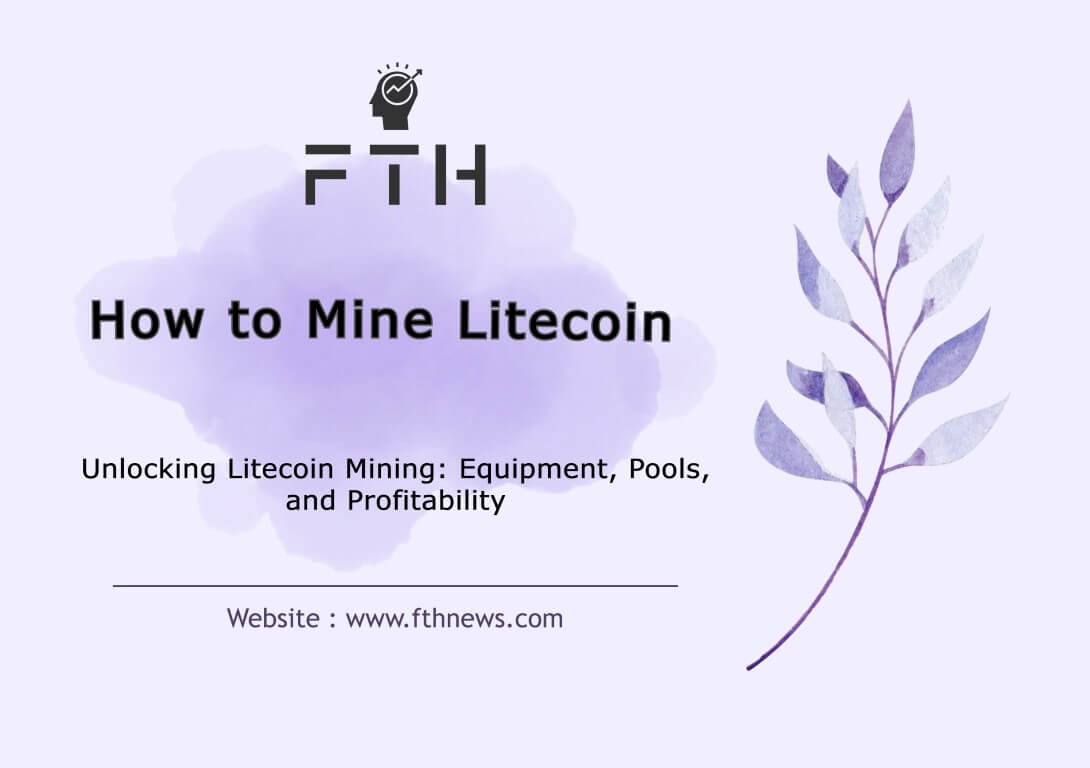
Mine Litecoin: Equipment, Pools, Litecoin Mining Guide
If you’re looking to maximize your gains from digital currencies and investments, mining should undoubtedly be on your radar. In this article, we will provide you with a step-by-step guide on how to mine Litecoin (LTC). Stay with us as we delve into the world of Litecoin mining and introduce you to the concept of mining pools.
How to Mine Litecoin: A Step-by-Step Guide”
At the core of Litecoin mining lies the need for specialized mining hardware, a requirement that underscores the ever-expanding mining industry. Gone are the days when ordinary home computers could effectively mine cryptocurrencies like Bitcoin and Litecoin. In the modern mining landscape, the primary cost associated with mining activities centers around hardware acquisition. Beyond the mining machine itself, another critical consideration is the availability of suitable electrical power, as cryptocurrency mining consumes a substantial amount of energy. The cost and quality of this electricity supply significantly impact the profitability of your mining venture.
Crucial Components for Successful Litecoin Mining:
Litecoin Wallet: A Litecoin wallet is your digital vault for storing the Litecoins you mine. It’s essential for securely managing and accessing your earned coins. Select a reputable and secure wallet that suits your needs.
Stable Internet Connection: A reliable and consistent internet connection is paramount for uninterrupted mining operations. Whether through ADSL or TD-LTE, a stable connection ensures your mining rig can communicate effectively with the network.
Electrical Infrastructure: Adequate electrical cables and equipment are crucial to handle the power demands of your mining setup. Ensure your infrastructure is safe, compliant with electrical codes, and capable of supporting your mining hardware.
Cooling Equipment (Air Conditioning): Given the heat generated by mining hardware, effective cooling is essential. Cooling systems, such as air conditioning, help maintain optimal operating temperatures, ensuring the longevity and efficiency of your mining equipment.
Conclusion:
In the contemporary landscape of cryptocurrency mining, these components form the backbone of your mining venture. Acquiring the right mining hardware, securing a reliable power source, setting up a secure Litecoin wallet, and maintaining a stable internet connection are prerequisites for success. Coupled with proper cooling measures and electrical infrastructure, these elements collectively lay the foundation for a profitable Litecoin mining operation.
Before we delve into the process of Litecoin mining, it’s crucial to emphasize a critical point: never invest more than you can afford to lose in digital currencies. Cryptocurrency markets are notorious for their price volatility, which can significantly impact the profitability of trading or mining. Therefore, before embarking on Litecoin mining, it’s essential to calculate the associated costs and carefully consider potential risks.
Now, let’s explore the fascinating world of Litecoin mining, where the process is remarkably similar to that of Bitcoin. While Bitcoin takes approximately 10 minutes to generate each block and confirm network transactions, Litecoin achieves the same in a mere 2.5 minutes. This shorter block generation time translates to quicker transaction confirmations and contributes to Litecoin’s growing popularity.
Litecoin Mining Methods: Individual vs. Mining Pools
In the world of Litecoin mining, you have two primary options, each with its unique advantages and considerations. Let’s start by examining the first method:
1. Individual Extraction:
In this approach, you take full control of your mining operation. You select and manage all the equipment needed for mining, and any profits earned from mining Litecoin are exclusively yours. However, there’s a significant catch — you shoulder the entire responsibility for covering electricity costs, acquiring mining equipment, and maintaining it.
As previously mentioned, the more potent your mining devices, the greater your chances of successfully mining a new block. So, if you have the financial means to cover the expenses and the physical space to house the equipment, individual Litecoin mining can be a profitable venture.
On the flip side, we have an entirely different method:
2. Joining Mining Pools:
This method stands in stark contrast to solo mining. Miners unite their computational power and resources by joining a mining pool. Naturally, the stronger and larger the pool, the higher the chances of everyone in the pool receiving Litecoin rewards. To participate in any mining pool, you typically need to pay a fee and share the electricity and computing power of your mining device with others.
In this method, you have the flexibility to employ CPU, GPU, or ASIC mining devices. Among these three, CPU and ASIC devices come with varying price tags, with ASICs being the more expensive option. Due to the significantly higher success rate of ASIC devices compared to others, this article will guide you on how to mine Litecoin using ASIC technology.
Exploring Litecoin Mining Pools
Now that we’ve delved into the two primary Litecoin mining methods—individual extraction and joining mining pools—it’s time to take a closer look at some of the prominent mining pools available. It’s important to note that when you join any of the pools we introduce below, you’ll typically need to pay a fee. Additionally, the payment model adopted by these pools is generally PPS, or Pay Per Share. In simple terms, your Litecoin mining profits are determined by the computing power and electricity consumption of your hardware within the pool’s system.
Antpool Pool:
Antpool stands as one of China’s leading mining pools, catering not only to Litecoin mining but also Bitcoin and Ethereum. One notable advantage of this pool is the absence of registration fees, making it accessible to miners of all backgrounds. Moreover, miners have the convenience of daily profit withdrawals from their accounts, ensuring a consistent and accessible stream of earnings.
F2pool Pool:
F2pool, also known as Discus Fish, has been a prominent player in the Litecoin mining scene since its establishment in 2013. This pool boasts a reputation for delivering higher profits, but it does come with slightly elevated subscription fees compared to other options. F2pool adopts a tiered harvesting system, meaning that once your earnings reach a specified threshold, you can initiate withdrawals from your account, providing a clear path to manage your returns effectively.
ViaPool Mining Pool:
ViaPool is a substantial player in the Litecoin mining pool arena, boasting a large and active community of over 16,400 miners. Miners can gauge their potential earnings by referring to the pool’s hash rate chart. A notable development on the horizon is ViaBTC’s plan to allow its miners to participate in Bitcoin transactions, further expanding the pool’s appeal. One standout feature of ViaBTC is its user-friendly profit calculator, which aids miners in estimating their future Litecoin mining earnings.
Litecoinpool Mining Pool:
Litecoinpool.Org stands as one of the premier Litecoin mining pools, priding itself on robust security measures, including two-factor authentication. The pool has implemented a minimum withdrawal threshold, requiring miners to accumulate at least 1 Litecoin in their accounts before making a withdrawal. Moreover, Litecoinpool offers the flexibility of mixed mining. Miners can configure their settings to mine other digital currencies while receiving Litecoin as their reward, enhancing diversification and potential profitability.
Litecoin Mining Technical Insights”
Understanding Hash Rate:
To fully grasp and assess each Litecoin mining method, it’s essential to delve into some technical aspects of this field. Among these, one of the most crucial is the concept of hash rate, a pivotal factor that determines network security and safeguards against potential hacker attacks.
What is Hash Rate?
In simple terms, hash rate refers to the number of calculations a computer or miner can perform within a specified timeframe while attempting to solve a cryptographic puzzle. It serves as an effective measure of the cumulative computing power dedicated to Litecoin mining.
Why is Hash Rate Important?
As mentioned earlier, hash rate plays a pivotal role in determining the computational prowess of the entire network. Put plainly, the higher the hash rate, the fiercer the competition and, consequently, the increased complexity of calculations.
How is Hash Rate Measured?
Hash rate is quantified in hash per second (H/s). Currently, Litecoin boasts a hash rate of approximately 300 terahashes per second (300 Th/s), signifying that a staggering 300 trillion calculations are executed per second across the network.
Understanding the network’s hash rate holds profound significance. Given the limited computational capabilities of standard computer systems, they stand little chance in the competitive mining landscape. Litecoin mining now necessitates powerful ASIC (Application-Specific Integrated Circuit) devices to remain viable.
Assessing CPU and GPU Processing Power:
In the early days of Litecoin’s introduction, its hash rate was modest, making it feasible to mine using ordinary CPU (Central Processing Unit) setups found in home computers. However, as the Scrypt hash function employed by Litecoin differed from Bitcoin’s SHA-256, it became apparent that GPUs (Graphics Processing Units) could achieve superior hash rates. Over time, CPU mining for Litecoin became obsolete.
Miners subsequently transitioned from GPUs to FPGA (Field Programmable Gate Arrays) configurations—modular equipment programmable to perform specific tasks. These FPGA circuits evolved into specialized hardware known as ASICs, exclusively designed for mining purposes.
With the advancement of mining equipment came heightened energy consumption and heat generation. To mitigate the impact of heat on device performance, robust cooling systems became indispensable. Consequently, the utilization of mining equipment became practical primarily for individuals possessing sufficient space and budgetary resources to maintain these sophisticated setups.
Choosing the Right Mining Hardware for Litecoin”
Introduction:
As we’ve explored earlier, Litecoin mining can be a profitable endeavor when approached with the right equipment, especially when combined with participation in a mining pool. In this section, we’ll introduce some of the top mining hardware options that can significantly increase your chances of success in the Litecoin mining world.
1. FutureBit Apollo Pod Mining Device:
The FutureBit Apollo Pod stands as a solid choice for Litecoin mining, particularly for those mindful of energy efficiency. While it may not pack the same punch as larger machines, its lower energy consumption makes it an attractive option. In economy mode, this device can achieve a hash rate of up to 135 Mh/s, consuming a mere 1 W per Mh, or 1.4 W in turbo mode.
An added advantage is the inclusion of a 64 GB USB drive pre-loaded with the LTC blockchain, reducing the time needed for synchronization with the network and expediting the mining process.
2. AntMiner L3+ Mining Machine:
The AntMiner L3+ is another reliable choice in the world of Litecoin mining hardware. It consumes slightly more energy than the Apollo Pod, operating at 1.6 W per Mh, but it compensates with an impressive computing power of up to 504 Mh/s. This machine boasts a dual cooling system designed to effectively dissipate excess heat generated during operation.
3. A6+ LTC Master Extractor:
For those deeply committed to Litecoin mining, the A6+ LTC Master is a powerhouse ASIC device with a staggering 2.2 Gh/s of hashing power. However, this level of performance comes at a cost, as it consumes a substantial 2.2 kWh of energy.
Litecoin Mining Rewards:
Much like Bitcoin, Litecoin features a limited supply, capped at approximately 84 million coins. This scarcity factor, in contrast to fiat currencies, which can lose value through excessive printing, plays a pivotal role in the price dynamics of digital currencies. As of the time of writing, the reward for mining each new Litecoin block is 12.5 LTC, subject to halving events.
These halving events reduce the block reward, which started at 50 LTC, and it continues to decrease over time. By the year 2142, the mining reward for Litecoin will ultimately reach zero, further enhancing its scarcity. The next Litecoin mining reward halving is expected in the next two years.
Conclusion:
In this article, we’ve delved into the methods of Litecoin mining and explored the dynamics of its mining rewards. Litecoin, a prominent Bitcoin fork, is among the top 12 cryptocurrencies and offers a more accessible mining experience than Bitcoin. However, it’s crucial to note that the increasing network difficulty in recent years has made it necessary to invest in powerful and, sometimes expensive, ASIC devices to effectively mine this digital currency.
Is Litecoin Mining Still a Profitable Venture?”
While Litecoin mining is relatively straightforward, it’s important to note that simplicity doesn’t equate to worthlessness. The profitability of mining this cryptocurrency today, considering the ever-increasing network difficulty, depends on several key factors: the choice of suitable mining equipment and whether you opt for individual mining or join mining pools. Your profit ultimately hinges on these decisions.
Benefits of Litecoin Mining:
Securing the Network: Litecoin mining plays a crucial role in safeguarding the integrity and security of the Litecoin blockchain. Miners validate transactions, ensuring they are accurate and legitimate.
Decentralization: By participating in Litecoin mining, you contribute to the decentralization of the network. This helps prevent central control and censorship.
Efficiency: Litecoin mining typically requires less electrical power compared to Bitcoin mining. This efficiency can translate into increased mining profits, especially in regions with lower energy costs.
Enhanced Security: Miners collectively secure the Litecoin network against potential threats and attacks.
Disadvantages of Litecoin Mining:
High Initial Capital: Acquiring the necessary mining equipment, such as ASICs, involves a significant initial capital investment. The cost of entry can be a barrier for some.
Hardware Power: The success of mining operations is heavily influenced by the power and capability of your mining equipment. More powerful machines tend to have a greater chance of mining success.
Maintenance Costs: Mining equipment necessitates ongoing maintenance to ensure optimal performance. This includes addressing issues related to heat generation and component wear and tear.
Price Volatility: The profitability of Litecoin mining is sensitive to the volatile nature of cryptocurrency prices. Fluctuations in Litecoin’s value can impact mining profitability.
In summary, Litecoin mining remains a potentially profitable endeavor when approached thoughtfully. While it’s not as straightforward as it once was, the choice of suitable equipment and mining method can make a significant difference. By understanding the benefits and disadvantages of Litecoin mining, you can make informed decisions that align with your financial goals and risk tolerance.
Calculating Litecoin Mining Profitability”
Determining the profitability of Litecoin mining involves several key factors, and one of the most effective ways to assess it is by utilizing a specialized mining calculator, such as “cryptocompare.” These calculators allow you to input essential data, including your mining hardware’s processing power, electricity consumption, and the cost of electricity. By doing so, you can obtain a rough estimate of your potential income. However, keep in mind that to evaluate the economic viability of Litecoin mining, you must also consider additional costs, such as the initial investment in mining equipment.
Steps to Calculate Litecoin Mining Profitability:
Use a Mining Calculator: Start by using a mining calculator like “cryptocompare” or similar tools available online. These calculators provide valuable insights into your expected earnings based on your mining hardware’s specifications.
Enter Key Data: Input crucial data into the calculator, including your mining device’s processing power (hash rate), electricity consumption (in kilowatt-hours or watts), and the cost of electricity in your region. This information forms the foundation for estimating your income.
Account for Additional Costs: Calculate and consider any side costs associated with your mining operation. This should include the initial purchase price of mining devices, cooling solutions, maintenance, and any other relevant expenses.
Determine Return on Investment (ROI): Estimating the time it will take to recoup your initial investment is a critical aspect of evaluating profitability. The shorter the ROI period, the more attractive the mining venture.
While it’s true that Litecoin mining has become increasingly competitive and demanding, it remains a viable option for those who carefully assess the costs and potential rewards. While it may seem that large mining operations and equipment manufacturers dominate the space, individuals and smaller-scale miners can still find profitability if they navigate the landscape wisely. The key is to approach Litecoin mining as a business endeavor, complete with thorough cost analysis and realistic profit expectations.














